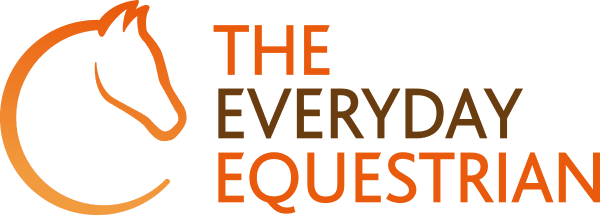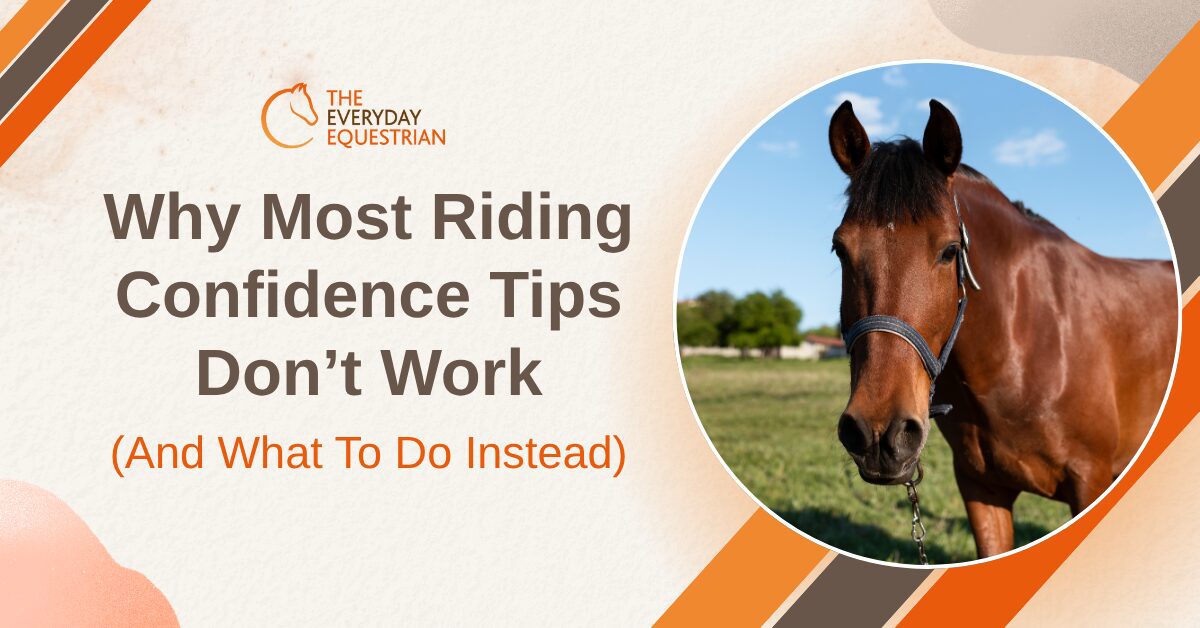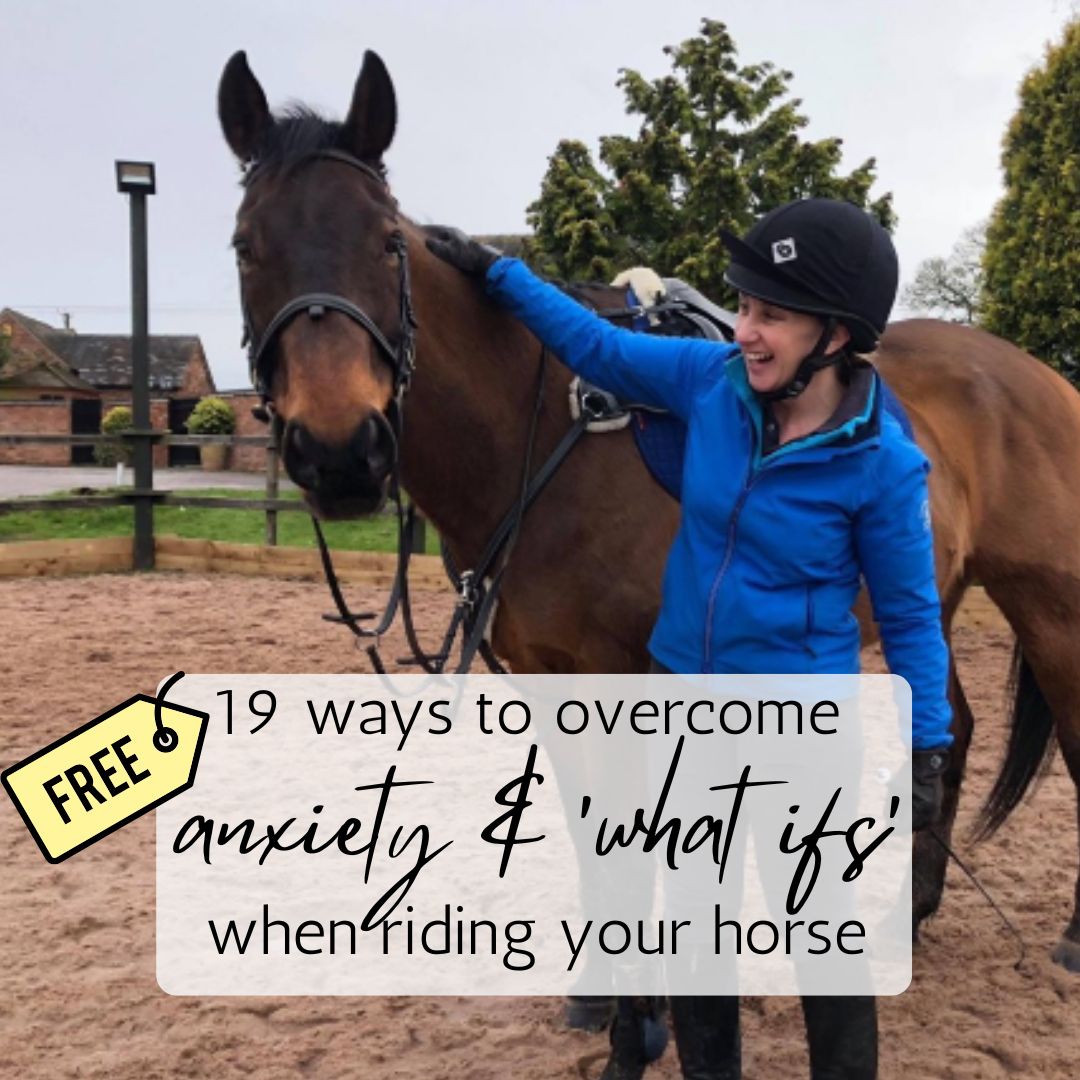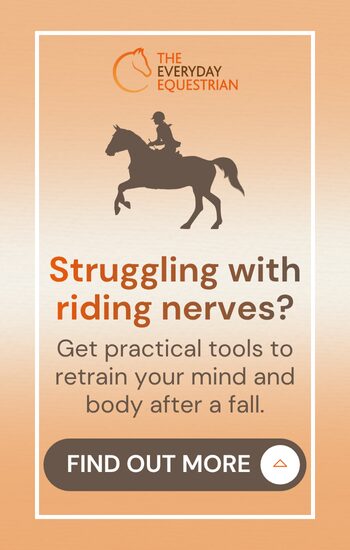Riding with shaky confidence is a bit like sitting on a wobbly chair.
You can sit on it. Technically, it works. But there’s always that sense of doubt, anxiety, and a jolt of tension underneath you. You’re not relaxed. You’re bracing, just in case it gives way.
Most riding confidence tips are like throwing a cushion on the seat. They might make things feel more comfortable in the moment… but they don’t fix the wobble. They don’t get underneath and tighten the screw that’s causing the problem in the first place.
That’s where so many riders get stuck.
You try to think positively. You ride through the nerves. You tell yourself it’ll get better, and sometimes it does, for a while. But then something knocks your confidence again, and you’re right back where you started.
If that sounds familiar, you’re not alone, and you’re not doing anything wrong.
In this post, we’ll explore why most riding confidence tips don’t last, what’s really going on when your nerves take over, and what you can do instead to build confidence that actually lasts, even when life gets wobbly.
Why Surface-Level Tips Don’t Stick
When your confidence takes a knock, it’s tempting to reach for the quick fixes – a deep breath, a pep talk, a positive thought to carry you through. And for a little while, they might seem to help. You get back on, push through the nerves, manage the ride, and tell yourself it’ll feel easier next time.
But sometimes, it doesn’t always feel easier. Sometimes, the nerves creep back in even stronger, and you’re left wondering why the strategies that worked yesterday suddenly don’t hold up today.
The reason is simple, but often overlooked. Most surface-level tips speak to the logical, thinking part of your brain, the part that wants to feel brave, calm, and capable. But when confidence has been shaken, it’s not just your thoughts that are affected. It’s your whole mind-body system.
After a fall, a frightening experience, or even repeated low-level stress in the saddle, your body stores those moments as warnings. It creates a link between riding and feeling unsafe, not as a conscious decision, but as a fast, automatic protective response.
Just like a car which detects a problem in the system will go into ‘limp mode’, your mind will default to scanning for potential threats, real or imagined, and limit what you do or don’t do.. Without you even realising it. This is why your heart races before you even get to the mounting block, why your stomach drops the minute you think about cantering, and why your legs shake even though your horse is standing still.
That protective response starts in the most ancient part of your brain, which works incredibly fast, way faster than conscious thought, and its only job is to keep you alive. When something happens that your system believes is threatening, even if it’s just similar to a past experience, like a fall or a moment where you felt out of control, this part of your brain acts automatically. It prepares your body to react by tensing muscles, speeding up your heartbeat, and narrowing your focus, all before you’ve had a chance to logically assess what’s going on. And because this reaction happens outside of conscious awareness, no amount of “thinking positively” will change it in the moment.
You can’t override a safety response with a mindset hack. You have to work with the part of your system that’s reacting, gently showing it over time that things are now different and that you are indeed safe right now.
This is where most tips fall short. They offer something to say or do after the response has already begun, hoping to override it with logic. But confidence doesn’t come from logic alone. It comes from helping your entire system feel safe again, not just in your mind but also in your body.
So if you’ve ever felt frustrated that deep breathing, positive thinking, or sheer willpower didn’t work, please know this – it’s not because you didn’t try hard enough. It’s because those strategies weren’t speaking to the part of you that needed the most support.
Real confidence is created in a different part of your mind, not by pushing through but by understanding what your mind and body are doing and why. Once you’ve got that, you can start to rebuild from the inside out, not just cover the cracks with a comforting phrase.
Confidence Isn’t a Switch, It’s a System
If you’ve ever told yourself to just snap out of it or hoped that one good ride might bring your confidence back, you’re not alone. That’s the kind of message riders often absorb: that confidence is something you either have or don’t. That it’ll return all at once if you’re brave enough to push through.
But confidence doesn’t work like that. It’s not something you can switch back on. It’s a system that needs the right conditions to grow. It requires repetition, consistency, a process to follow, and a sense of safety.
And when you understand that system, it becomes much easier to see why you feel the way you do and what to do about it.
Confidence isn’t just about how you feel in the saddle. It’s shaped by your thoughts, emotions, habits, beliefs about yourself and your horse, and the support you have around you. These things are all closely interlinked. When one part is off, the whole thing feels shaky.
You might be great at managing your horse, but you still feel anxious every time you ride alone. Or you might be making slow, steady progress in practice, but find yourself derailed by one setback because the emotional foundation isn’t strong yet.
That’s why I created the Rider Confidence Success Track inside my membership. It’s built to provide the whole picture and process, not just the superficial. It doesn’t rely on quick wins or pushing harder. It’s a structured, step-by-step process that helps you rebuild your confidence properly and at your own pace.
Each stage focuses on a specific part of the confidence system and gives you tools that match where you are right now.
- Stage 1: Confidence Compass helps you identify what’s really going on under the surface. You’ll start to notice your own patterns in how you think, feel, act and react.
- Stage 2: Confidence Foundations helps you calm your system, so you feel physically safer and more grounded. Without this, progress just doesn’t stick.
- Stage 3: Confidence Breakthroughs gives you strategies to reduce the emotional weight of fear and anxiety, and shift the old patterns that keep showing up.
- Stage 4: Confidence Solutions focuses on the specific situations that often trigger nerves, like hacking out, mounting up, or getting back to cantering.
- Stage 5: Confidence Evolution supports you to keep going, even when life is busy, your routine changes, or you hit a wobble. This is where confidence becomes sustainable.
None of this is about fixing you; you already have everything you need within you. Instead, it’s about understanding what’s actually happening when your confidence feels shaky, and working with it in a way that makes sense.
Confidence that lasts isn’t built from grit alone. It comes from feeling safe, supported and in control. When you work with your system rather than against it, things finally start to shift.
What Actually Works
If the usual tips and tricks haven’t helped, the issue isn’t that you’re not trying hard enough. Those strategies often work on the surface, while the real shift happens deeper down. Confidence grows when you stop trying to force it and start working with how your system actually responds.
It all begins with awareness. Noticing how you feel, what thoughts are coming up, and where those feelings show up in your body. That might be a tightness in your chest, a heavy feeling in your stomach, or a rush of thoughts before you’ve even touched the reins. The aim here isn’t to fix anything or get it right. It’s simply to notice, without judgment. If self-criticism creeps in, like telling yourself “Why am I still like this?” or “I should be over this by now,” try to let that go.
When you know where nerves tend to show up, whether at the mounting block, when you pick up the trot, or even when you start thinking about riding, you begin to understand your current responses. And that understanding creates space. With space, you have more choice. You can start to respond differently, without force or pressure.
Spot the Pattern
Confidence struggles often repeat themselves. You might find yourself backing out of rides, avoiding specific routes, or going into autopilot panic when things feel uncertain. These reactions aren’t random. They’re learned patterns your system has repeated enough times that they now run on their own.
Noticing these patterns helps you break them. When you can see what’s happening, you create a gap between the trigger and the reaction. That’s where you can begin to make a new choice.
This doesn’t mean overthinking every feeling. It just means paying quiet attention and spotting the habits that no longer serve you, so you can start to shift them gently and without pressure.
Settle Your System
When your body feels unsafe, it behaves as if something is about to go wrong. Your muscles tense, your breathing shortens, and your focus narrows. These responses happen fast and automatically, and no amount of positive thinking can override them if your system still feels under threat.
To shift the response, you need to start with the body. Begin by slowing your breathing, especially the out-breath. Let your shoulders drop. Unclench your jaw. Soften your gaze. These small physical shifts are often enough to signal to your brain that you are safe, even if a moment ago it wasn’t sure.
When your body starts to settle, your thoughts usually follow. This is how you create the conditions for confidence to return, not through force, but through calm, steady regulation.
Small, Consistent Steps
Confidence doesn’t come from big leaps. It comes from repeating small, achievable actions that help your system feel steady and in control. These moments create a new track record for your brain to rely on.
Choose something simple and manageable. You could simply sit on your horse without actually riding or going anywhere. Maybe you ride the same short loop until it feels boring. Perhaps you just practise walking on a loose rein for a few minutes. These don’t look like dramatic wins, but they’re the foundations of something solid.
Each calm experience becomes evidence. And the more evidence you collect, the more your system begins to believe that riding can feel safe again. This isn’t about tricking yourself. It’s about giving your brain and body the chance to catch up with the rider you’re becoming.
Prepare with Purpose
Before you ride, take a few quiet minutes to imagine how you want things to feel. How do you really want this experience to happen? Picture yourself breathing steadily, your horse walking forward in rhythm, your hands feeling light on the reins. Imagine the moments where you tensed up in the past, and see yourself responding calmly and confidently instead.
This isn’t about wishful thinking. It’s about preparing your system for what’s ahead, so that it feels more familiar and less unpredictable. The more your brain recognises something, the less likely it is to treat it as a threat.
By bringing intention into your preparation, you give yourself the best possible chance of riding with focus and calm. Not because you are pushing through fear, but because you are creating a steady foundation for confidence to grow.
Bringing It All Together
Building confidence isn’t about pushing harder or pretending you feel fine. It’s about understanding what’s really going on and creating the right conditions for things to feel safer, calmer and more manageable again.
Most tips don’t get to the root of the issue. They try to fix what’s happening on the surface, without supporting the deeper process that helps confidence grow in a lasting way.
But things begin to shift when you start to notice your patterns, support your nervous system, and take steady, purposeful steps. Rides feel less tense. Setbacks don’t feel so heavy. And you start to find a way back to enjoying your horse again.
You don’t have to figure it out alone – there is a clear path forward, and you can take it at your own pace.
Your Next Step Starts Here
If you’re ready to move forward with more structure, support and breathing space, the Crack the Confidence Code Membership is here to help.
Inside, you’ll find the full Rider Confidence Success Track, a step-by-step process that meets you where you are and helps you make steady, lasting progress, without overwhelm or having to do it all on your own.
You’ll also get access to practical tools, regular mindset support, and a kind, encouraging community of riders who genuinely understand what it’s like to lose confidence and want to get it back, gently and safely.
If you’re tired of quick fixes and want a more thoughtful, effective way to rebuild your confidence, this is your next step.



